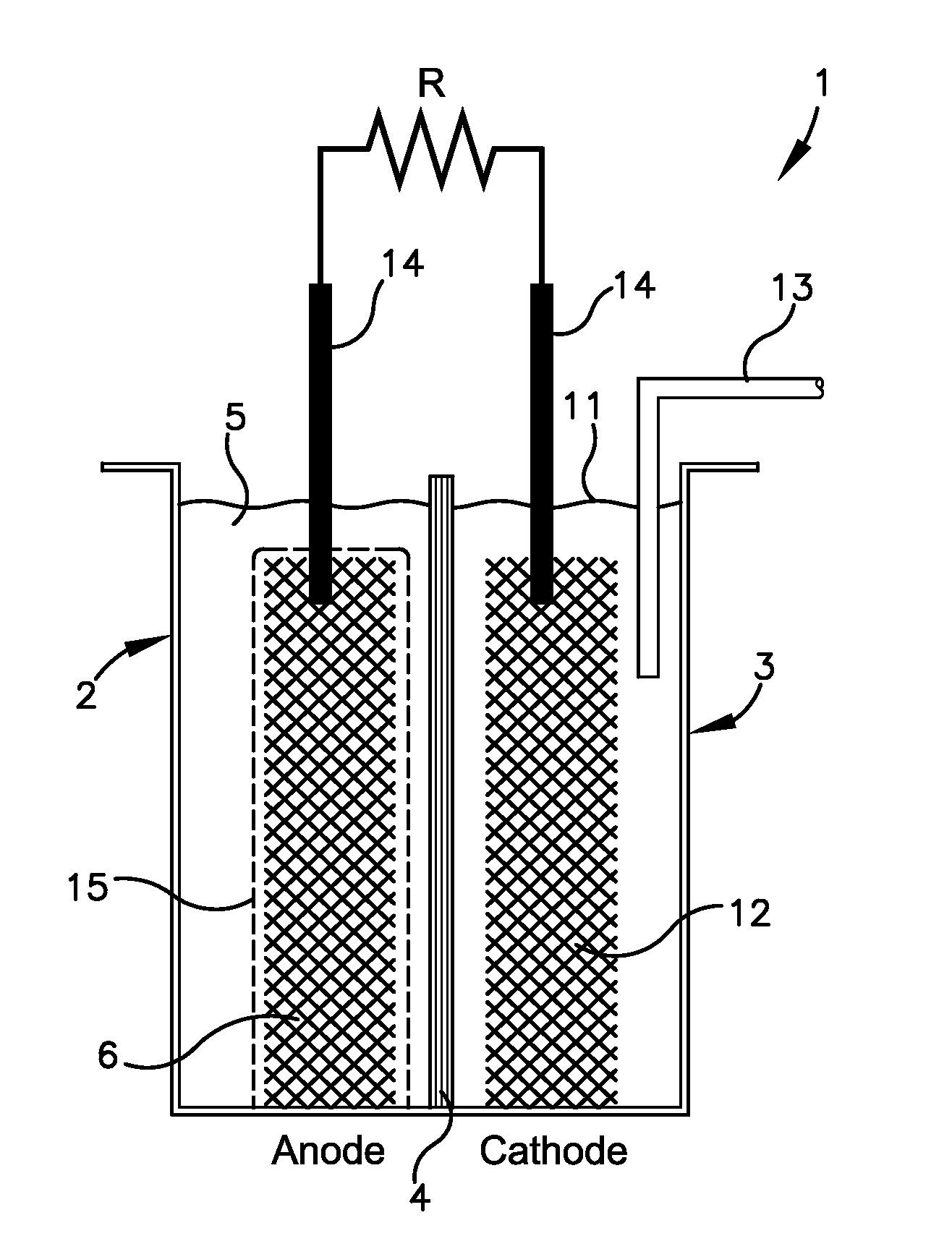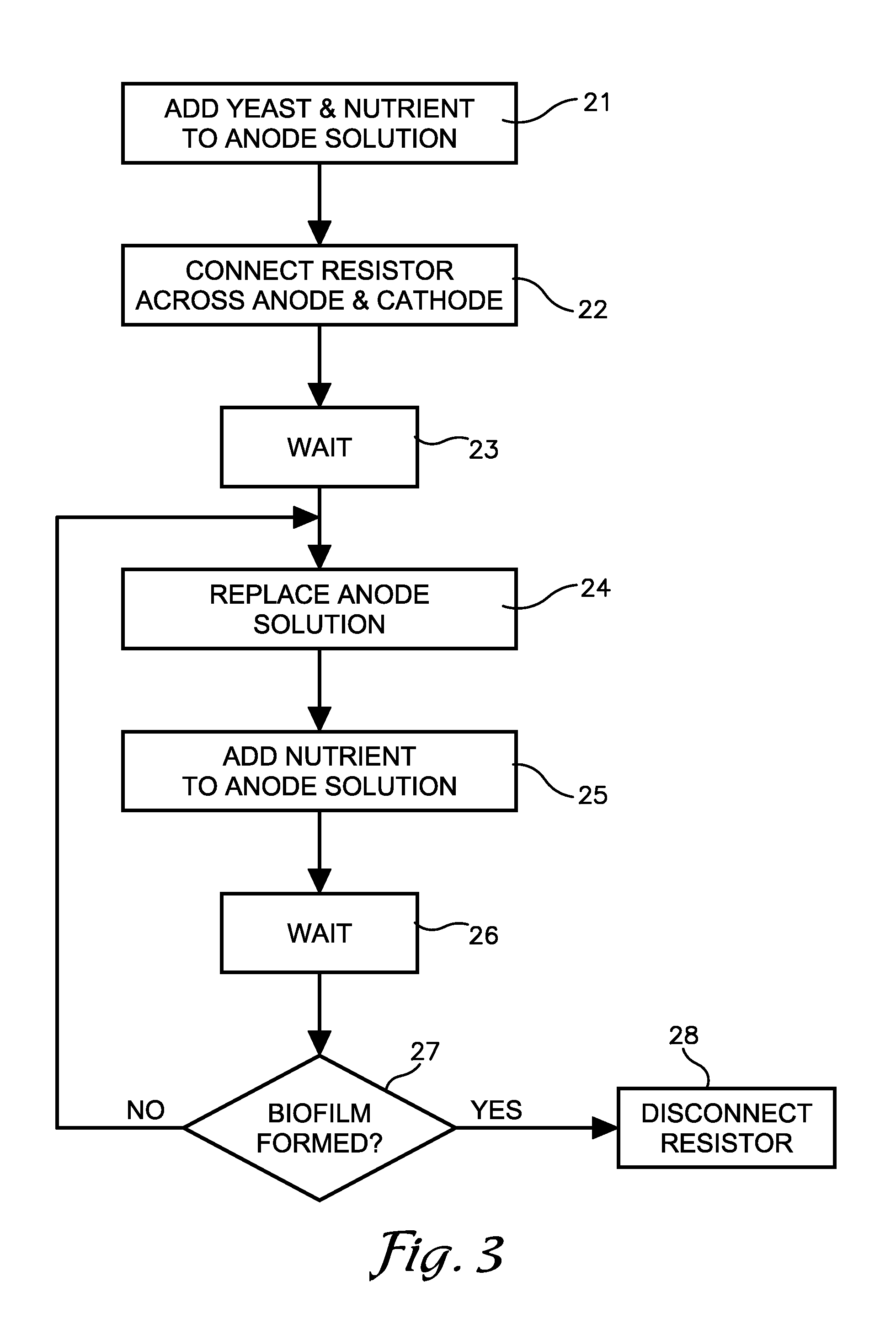Yeast biofilm based fuel cell
a biofilm and fuel cell technology, applied in the field of microbial fuel cells, can solve the problems of low power generated by such mfcs per unit of volume, and yield a very low fuel cell power density
- Summary
- Abstract
- Description
- Claims
- Application Information
AI Technical Summary
Benefits of technology
Problems solved by technology
Method used
Image
Examples
example protocol
[0024]Microbial fuel cells (MFCs) were prepared for use in the subsequent examples in accordance with the following protocol:
[0025]Fleischmann's rapid rise baker's yeast (S. Cerevisiae) was resuscitated for 20 minutes in nutrient solution at temperatures of from 37-41° C. prior to each use. A 20 mg / ml solution based on dry yeast weight was used. A modified minimal M9 salts nutrient medium solution was prepared (1× M9 salts; 2 mM MgSO4; 0.1 mM CaCl2; 0.4% carbon source) using sterile water. A quantity of 2% dextrose (American Biosciences) was used as the sugar (carbon) source. A quantity of Methylene blue electron mediator in the chloride salt form (Sigma Aldrich) was made into 60 mM stock solutions by completely dissolving the salt in deionized water. Solutions with desired concentrations of electron mediator were prepared by adding appropriate amounts of the stock electron mediator solution to the M9 solution.
[0026]Microbial fuel cells were constructed using carbon felt as both the...
example i
[0028]A conventional planktonic yeast microbial fuel cell (MFC) was prepared in accordance with the Example Protocol except that the M9 solution was used without addition of the electron mediator stock solution and the cell was not operated under 5000 ohm load in between the power readings.
[0029]The results of polarization measurements used to determine maximum power density of the planktonic yeast MFC are shown as the lower plot in FIG. 2. The power density was not observed to change, was observed to remain constant at about 25 μW cm−2 and remained constant for a period of about 2 weeks.
example ii
[0030]A baker's yeast biofilm anode MFC was prepared as follows:
[0031]Yeast biofilms were formed on electrically biased anodes by first exposing the anodes to planktonic yeast suspension, and subsequently exposing the anodes with attached yeast cells to pure nutrient solution and an electron mediator. The first 3 days of preparation were identical to fabrication of the conventional planktonic yeast MFC described in the Example Protocol. However, subsequent to replacement of the solution in the anode chamber and the addition of pure nutrient solution containing no additional yeast, the anode solution was replaced with pure nutrient solution at the end of each day. The power density of the fuel cell was also measured at the end of each day. As shown in the upper plot in FIG. 2, the power density of the cell increased from about 10 μW cm−2 at the end of day 3 to 50 μW cm−2 (300 μW) at the end of day 6 during this time. No further increase of power density was observed with time. In con...
PUM
 Login to View More
Login to View More Abstract
Description
Claims
Application Information
 Login to View More
Login to View More - R&D
- Intellectual Property
- Life Sciences
- Materials
- Tech Scout
- Unparalleled Data Quality
- Higher Quality Content
- 60% Fewer Hallucinations
Browse by: Latest US Patents, China's latest patents, Technical Efficacy Thesaurus, Application Domain, Technology Topic, Popular Technical Reports.
© 2025 PatSnap. All rights reserved.Legal|Privacy policy|Modern Slavery Act Transparency Statement|Sitemap|About US| Contact US: help@patsnap.com



